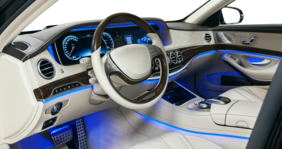LIN bridge: Overcomes the 16-nodes limitation

The LIN bridge allows to connect more than 16 LIN slave nodes to a LIN master node. The LIN bridge can be used, for example, to link to a body control module (BCM) a sub-layered LIN segment connecting 16 additional RGB slave modules driving multiple LEDs. The in the bridge embedded 16-bit micro-controller features a 32-KiB flash-memory with error correction capability (ECC), a 380-byte EEPROM with ECC, and a 2-KiB RAM. The ROM comes pre-loaded with a LIN driver, boot-loader, math library and an RGB color mix algorithm. The bridge can be configured to meet customer needs via the flash memory.
The LIN slave protocol controller operates up to 19,2 kbit/s and is compliant with LIN 2.0, LIN 2,1, LIN 2.2A, and SAE J2602 (2012). It processes frames autonomously; ensuring that there are very few interrupts to the main application. Also included in the MLX81120 are a master and slave LIN transceiver, both of which are also compliant with above-mentioned LIN specifications. The second master transceiver enables a decentralized ambient lighting architecture within a car, which makes it possible to add and change lighting functions for different car models or equipment options without changing the BCM or lighting ECU.
The built-in I/O capability includes four high voltage I/O lines, 16-bit PWM-output, interrupt capable inputs and a 10-bit analog-digital converter with an integrated pre-driver. The bridge has an efficient voltage regulator that consumes 20 ?A in sleep mode. Other features include LED temperature compensation, LED leakage compensation and control and an integral battery with temperature monitor.
Michael Bender, Melexis’ product line manager lighting commented: "As lighting solutions proliferate, especially within the cabin designers have told us they need a simple way to overcome the architectural limits of LIN. The MLX81120 does exactly that, allowing lighting bus segmentation and extension for future use cases. Furthermore, the device reduces the board space (and cost) significantly, while providing many useful features and protections. For example, even by adding extensive lighting functionalities the existing body control module can be kept as simple as possible."
Offering an automotive temperature range of -40 °C to +125 °C and housed in a DFN4x4 12?pin package the LIN bridge is available as PPAP samples, along with a useful demo board and development software.